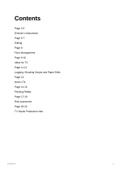Lecture notes
TV Studio Production
- Module
- TV Studio Production
- Institution
- University Of Bedfordshire
Contents Page 2-5 Director’s Instructions Page 6-7 Editing Page 8 Floor Management Page 9-10 Ideas for TV Page 11-12 Logging, Shooting Scripts and Paper Edits Page 13 News VTs Page 14-16 Pitching Pitfalls Page 17-19 Risk assessment Page 20-22 TV Studio Production Intro
[Show more]



